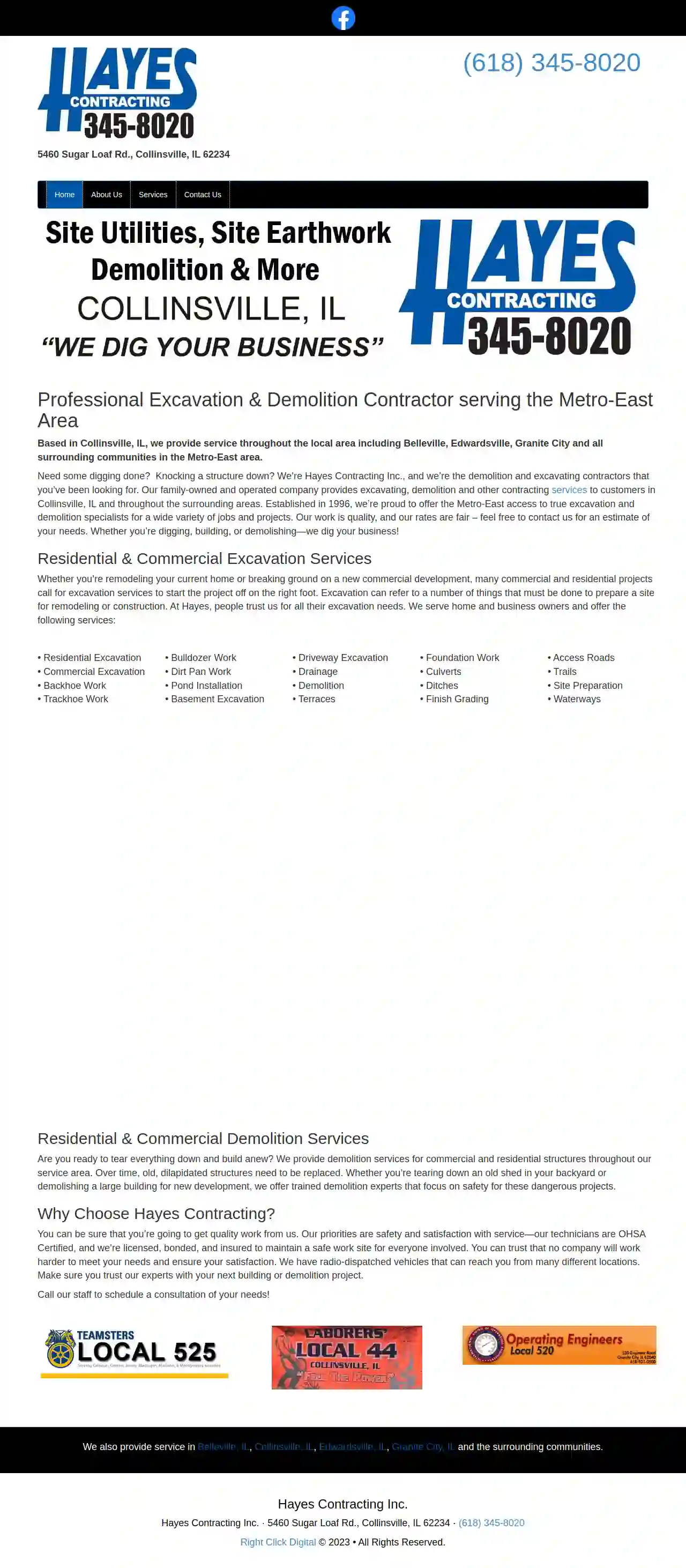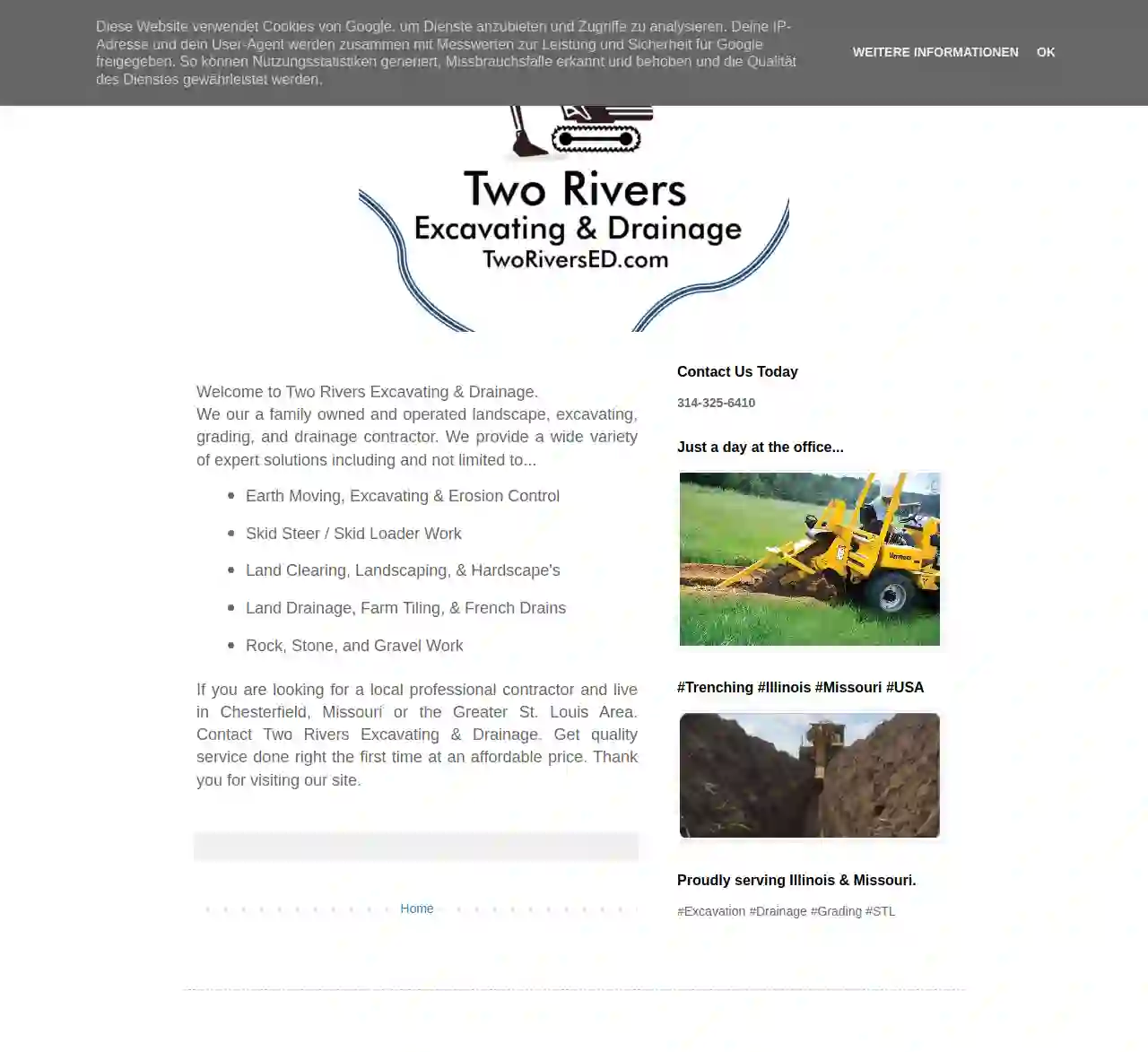Excavation Contractors Imperial
Top Excavating Contractors in Imperial
Receive multiple Digging Contractors quotes for your project today! Compare profiles, reviews, accreditations, portfolio, etc... and choose the best service.

Flow King Rooter Plumbing
512 reviews111 W Port Plaza, 111 W Port Plaza St Louis, MO, St. Louis, 63146, USWhen you need a dependable plumber that you can count on, we will be here for you. Here at Flow King Rooter, we provide top quality plumbing services to you that can’t be beat. When it comes to your home, we know that everything needs to be on the top of its game. That is why we offer emergency care and are available to you to ask questions and get you the repairs that you need at the most convenient time to you. Our technicians have worked hard to get to where they are and they bring the spirit of our company to every job they do. That means that we will always call you when we are on our way so that you are never caught off guard. We also make sure that you understand what we are doing even before we do it so that you have peace of mind that the service will be done right. We try to remain affordable as well because we believe that everyone should have properly working plumbing in their home or commercial building. Our plumbers are trained, certified, and have the experience that you want in your plumber. If you are looking for top quality plumbing in St Louis, , give Flow King Rooter a call today at 314-348-7503 and we will be happy to set you up with an appointment time that works best for you.
- Services
- Why Us?
- Gallery
Get Quote
Flow King Rooter
4.786 reviews111 W Port Plaza, 111 W Port Plaza St Louis, MO, St. Louis, 63146, USWhen you need a dependable plumber that you can count on, we will be here for you. Here at Flow King Rooter, we provide top quality plumbing services to you that can’t be beat. When it comes to your home, we know that everything needs to be on the top of its game. That is why we offer emergency care and are available to you to ask questions and get you the repairs that you need at the most convenient time to you. Our technicians have worked hard to get to where they are and they bring the spirit of our company to every job they do. That means that we will always call you when we are on our way so that you are never caught off guard. We also make sure that you understand what we are doing even before we do it so that you have peace of mind that the service will be done right. We try to remain affordable as well because we believe that everyone should have properly working plumbing in their home or commercial building. Our plumbers are trained, certified, and have the experience that you want in your plumber. If you are looking for top quality plumbing in St Louis, , give Flow King Rooter a call today at 314-348-7503 and we will be happy to set you up with an appointment time that works best for you.
- Services
- Why Us?
- Gallery
Get Quote
Riebold Excavating & Construction .
54 reviewsSt. Louis, USDennis Riebold Excavating and Construction Dennis Riebold Excavating and Construction has been in business for over 30 years, developing subdivisions, new construction, custom homes, and commercial sites. We also do a lot of tear-down work; removing old driveways and tearing down buildings so that the site can be redeveloped. Our experience in excavation, grading, and underground utility installation gives us a unique edge in the industry. We are able to take on projects from start to finish, designing and developing the site as needed. We take pride in our reputation as a professional contractor who always puts the customer first. With our extensive experience in all aspects of excavation and construction, we can handle any project, large or small. We're also experts at tearing out old driveways and preparing sites for new pavement.
- Services
- Why Us?
- Gallery
Get Quote
Excavating St. Louis
51 reviewsBarnhart, USResidential & Commercial Excavation Services throughout St. Louis City, County & Jefferson County No job is too large or too small, we are here to help. Our team of skilled professionals is here to provide you with all your excavation needs. We specialize in residential and commercial projects, including sewer line repairs, land clearing, site preparation, and grading. At Excavating St. Louis, we are committed to delivering exceptional services that exceed your expectations. Contact us today to learn more about how we can help you with your next project. Call (636) 288-6627 for your free estimate today. Trusted Experience Whether you’re planning a new build or in need of a sewer line repair anywhere in St. Louis and Jefferson County, we have you covered. With over 20 years in the industry, we are able to plan and execute a variety of excavating projects that include land clearing, digging, grading, demolition and sewer line repairs. Professional Service We are experienced, fully insured professionals ready to provide prompt and reliable services. We know how to prioritize and multi-task to ensure your project is completed with quality workmanship. Count on us to provide efficient, safe, and high-quality sitework services.
- Services
- Why Us?
- Gallery
Get Quote
Williams Construction & Excavating, LLC
51 reviews21726 Palmer Lane, Saint Mary, 63673, USOver 45 Years of Experience Williams Construction & Excavating, LLC is a local, family-owned excavation company dedicated to delivering the best possible results on every project. We specialize in several areas, including septic installation, constructing lakes and ponds, soil and water projects, demolition, and general excavating. We are equipped with a wide range of machinery to meet the needs of residential, commercial, and agricultural projects. Kenny Williams, the owner of Williams Construction & Excavating, has been in the business for over 45 years. Kenny's knowledge and experience allow him to deliver the high-quality results his customers expect. Born and raised in the Ozora, Missouri area, Kenny knows the diversity of the soils and the rock layers in Ste. Genevieve, Perry, St. Francis, and Cape counties. Williams Construction & Excavating, LLC is a second-generation-owned and third-generation-run business. Floyd Williams began the company back in 1973, and he passed it down to Kenny in 2014. Kenny's sons, Joe and Jonathan, both work for the family business. Our Team Left to Right: Jonathan Williams, Joe Williams, and Kenny Williams
- Services
- Why Us?
- Our Team
- Gallery
Get Quote
Hayes Contracting Inc
53 reviews5460 Sugar Loaf Rd., Collinsville, 62234, USProfessional Excavation & Demolition Contractor serving the Metro-East Area Based in Collinsville, IL, we provide service throughout the local area including Belleville, Edwardsville, Granite City and all surrounding communities in the Metro-East area. Need some digging done? Knocking a structure down? We’re Hayes Contracting Inc., and we’re the demolition and excavating contractors that you’ve been looking for. Our family-owned and operated company provides excavating, demolition and other contracting services to customers in Collinsville, IL and throughout the surrounding areas. Established in 1996, we’re proud to offer the Metro-East access to true excavation and demolition specialists for a wide variety of jobs and projects. Our work is quality, and our rates are fair – feel free to contact us for an estimate of your needs. Whether you’re digging, building, or demolishing—we dig your business!
- Services
- Why Us?
- Gallery
Get Quote
Bullseye Contracting llc
57 reviewsSt. Louis, USBuilding Trust with Quality Work Bullseye Contracting offers general excavation work including: pond & lake building, road & property line clearing, leveling roads, culvert & ditch installation, basement excavation, demolition, hauling, soil retention, brush clearing, water retention & diversion, wildlife land management, hunting food plots and pad prep for portable storage sheds & buildings! We offer an end-to-end client experience that includes communication, budgeting, staffing, on-site organization, along with solid, quality handiwork every time. Our mission at Bullseye Contracting is to provide our clients with exceptional construction services that exceed their expectations. We strive to deliver high-quality workmanship, on-time completion, and cost-effective solutions.
- Services
- Why Us?
- Gallery
Get Quote
Two Rivers Excavating & Drainage
St. Louis, USWelcome to Two Rivers Excavating & Drainage. We are a family owned and operated landscape, excavating, grading, and drainage contractor. We provide a wide variety of expert solutions including and not limited to... Earth Moving, Excavating & Erosion Control Skid Steer / Skid Loader Work Land Clearing, Landscaping, & Hardscape's Land Drainage, Farm Tiling, & French Drains Rock, Stone, and Gravel Work If you are looking for a local professional contractor and live in Chesterfield, Missouri or the Greater St. Louis Area. Contact Two Rivers Excavating & Drainage. Get quality service done right the first time at an affordable price. Thank you for visiting our site.
- Services
- Why Us?
- Gallery
Get Quote
Kamadulski Excavating & Grdng
4.314 reviews4336 HWY 162, Granite City, 62040, USHistory of KAMEX Kamadulski Excavating & Grading Co, Inc. was founded in 1958 by Leo and Fannie Kamadulski. The Kamadulski family owned and operated the company until Leo and Fannie’s son, David Kamadulski, sold the company in 2019. The mission of the Kamadulski family was to deliver quality service to their customers at a fair price. Ryan Fischer and Mark Crays joined the company in 2013. Ryan and Mark purchased stock in the company in 2015 and completed the purchase in 2019. In 2021, the current ownership group rebranded the company as KAMEX. KAMEX has become an industry leader in the St. Louis Metro East. The company continues to expand into new sectors, including Commercial Warehouse Infrastructure, Environmental Landfill Cell Construction, Federal USACE Projects, Heavy Highway, Large Scale Transmission Water & Sewer Mains, Industrial, Mechanical, and Residential Subdivisions. Our Story Strong values of hard work and lasting relationships continue to define our culture. We work together as a team, supporting and encouraging each other. We have created an environment that values success in terms of relationships and results. Our mission is to offer our customers a quality experience and our staff an outstanding place to work and build their own legacy.
- Services
- Why Us?
- Gallery
Get Quote
TriTerra Forestry Mulching, Land Clearing & Grading
526 reviews1810 Grothe Rd, Wentzville, 63385, USProfessional Land Clearing Company in St. Louis, MO TriTerra Land Clearing is a professional land clearing company serving the St. Louis, MO area. We specialize in a variety of land clearing services, including honeysuckle clearing, forestry mulching, new construction clearing, property line clearing, trail clearing, and right of way clearing. We are fully insured and committed to providing our clients with the highest quality service at a fair price. The TriTerra Difference TriTerra is committed to providing our clients with the highest quality service at a fair price. We are fully insured and committed to providing our clients with the highest quality service at a fair price. We are fully insured and committed to providing our clients with the highest quality service at a fair price. We are fully insured and committed to providing our clients with the highest quality service at a fair price. Transparency + Trust You can trust us to treat your clearing project with the care it deserves. We walk you through the entire process, and answer any questions you might have. We are fully insured to protect you and your family.
- Services
- Why Us?
- Testimonials
- Gallery
Get Quote
Over 22,076+ Excavation Contractors in our network
Our excavation contractors operate in Imperial and surrounding areas!
ExcavationHQ has curated and vetted the Best Excavation Pros in Imperial. Find the most reliable business today.
Frequently Asked Questions About Excavation Contractors
- Mechanical Excavation: Utilizing heavy equipment like excavators, backhoes, bulldozers, and loaders, suitable for most projects.
- Hand Excavation: Using hand tools (shovels, picks) for smaller excavations or delicate work near utilities.
- Blasting: Employing explosives to break up rock or hard materials, typically for large-scale projects.
- Hydro Excavation: Using high-pressure water jets to loosen and remove soil, often used for locating utilities or delicate excavation.
- Vacuum Excavation: Employing a vacuum system to suck up excavated material, suitable for safe excavation near utilities or in confined spaces.
- Experience: Choose contractors with a proven track record and years of experience in excavation projects similar to yours.
- Licensing and Insurance: Verify that they are properly licensed to operate in your area and carry adequate insurance to protect you from liability in case of accidents or damage.
- Equipment and Resources: Ensure they have the necessary equipment and resources to handle your project efficiently and safely.
- Positive Reviews and References: Check online reviews and testimonials from previous customers. Request references and contact them to inquire about their experience with the contractor.
- Professionalism: Opt for a company that communicates clearly, provides detailed and transparent estimates, and has a responsive and courteous team.
- Soil Type and Stability: Stable, cohesive soils allow for deeper excavations than loose or unstable soils.
- Groundwater Level: Excavations below the water table require dewatering techniques to manage water intrusion.
- Equipment and Resources: The size and capabilities of excavation equipment influence the achievable depth.
- Safety Regulations: OSHA and other safety regulations impose limitations on trench depths without proper shoring or sloping.
- Project Requirements: The purpose of the excavation (basement, pool, foundation) determines the necessary depth.
- Excavators: Versatile machines with a bucket, arm, and rotating cab for digging, lifting, and moving earth.
- Backhoes: Similar to excavators but with a digging bucket on the back and a loader bucket on the front, ideal for trenching and smaller excavations.
- Bulldozers: Powerful machines with a large blade for pushing earth, clearing land, and leveling surfaces.
- Skid Steers: Compact and maneuverable loaders with various attachments (buckets, forks) for digging, loading, and grading in tight spaces.
- Trenchers: Specialized machines for digging narrow trenches for utilities.
- Dump Trucks: Vehicles for hauling excavated material to disposal sites.
What are the different methods of excavation?
How do I find a good excavation contractor?
How deep can you excavate?
What equipment is used for excavation?
What are the different methods of excavation?
- Mechanical Excavation: Utilizing heavy equipment like excavators, backhoes, bulldozers, and loaders, suitable for most projects.
- Hand Excavation: Using hand tools (shovels, picks) for smaller excavations or delicate work near utilities.
- Blasting: Employing explosives to break up rock or hard materials, typically for large-scale projects.
- Hydro Excavation: Using high-pressure water jets to loosen and remove soil, often used for locating utilities or delicate excavation.
- Vacuum Excavation: Employing a vacuum system to suck up excavated material, suitable for safe excavation near utilities or in confined spaces.
How do I find a good excavation contractor?
- Experience: Choose contractors with a proven track record and years of experience in excavation projects similar to yours.
- Licensing and Insurance: Verify that they are properly licensed to operate in your area and carry adequate insurance to protect you from liability in case of accidents or damage.
- Equipment and Resources: Ensure they have the necessary equipment and resources to handle your project efficiently and safely.
- Positive Reviews and References: Check online reviews and testimonials from previous customers. Request references and contact them to inquire about their experience with the contractor.
- Professionalism: Opt for a company that communicates clearly, provides detailed and transparent estimates, and has a responsive and courteous team.
How deep can you excavate?
- Soil Type and Stability: Stable, cohesive soils allow for deeper excavations than loose or unstable soils.
- Groundwater Level: Excavations below the water table require dewatering techniques to manage water intrusion.
- Equipment and Resources: The size and capabilities of excavation equipment influence the achievable depth.
- Safety Regulations: OSHA and other safety regulations impose limitations on trench depths without proper shoring or sloping.
- Project Requirements: The purpose of the excavation (basement, pool, foundation) determines the necessary depth.
What equipment is used for excavation?
- Excavators: Versatile machines with a bucket, arm, and rotating cab for digging, lifting, and moving earth.
- Backhoes: Similar to excavators but with a digging bucket on the back and a loader bucket on the front, ideal for trenching and smaller excavations.
- Bulldozers: Powerful machines with a large blade for pushing earth, clearing land, and leveling surfaces.
- Skid Steers: Compact and maneuverable loaders with various attachments (buckets, forks) for digging, loading, and grading in tight spaces.
- Trenchers: Specialized machines for digging narrow trenches for utilities.
- Dump Trucks: Vehicles for hauling excavated material to disposal sites.
